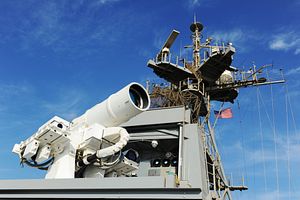The U.S. Navy recently test fired the world’s first operational and deployed laser weapons from a warship in the Persian Gulf. According to CNN, the world’s first active laser weapons system was fired from the Austin-class amphibious transport dock USS Ponce. The laser successfully destroyed an unnamed aerial vehicle (UAV) and moving surface targets.
The new weapon releases photons—elementary particles which transmit light—at the speed of light silently hitting their target and burning it to a temperature of thousands of degrees. Unlike depicted in movies such as Star Wars, the laser beam, essentially a narrow beam of focused light, is entirely invisible.
“It operates in an invisible part of the electromagnetic spectrum so you don’t see the beam, it doesn’t make any sound, it’s completely silent and it’s incredibly effective at what it does,” Lieutenant Cale Hughes, the laser weapons system officer aboard the USS Ponce told CNN.
Lasers are primarily intended for short-range defense (one to five miles) against aircraft, drones, and small boats. Second-generation laser weapons systems are currently under development intended to take on faster targets such as incoming ballistic missiles.
During previous tests, lasers have taken out cruise missiles, mortars and other projectiles, according to the U.S. Department of Defense.
The $40 million weapons system requires a crew of three and a supply of electricity (generated from its own small generator) to operate. The 30-kilowatt, laser weapon, installed aboard the USS Ponce already in 2014, is extremely accurate and can be scaled depending on the target.
“I can aim that at any particular spot on a target, and disable and destroy as necessary,” said the commanding officer of the USS Ponce, Captain Christopher Wells. “It reduces collateral damage — I no longer have to worry about rounds that may go beyond the target and potentially hurt or damage things that I don’t want to hurt or damage.”
“It is more precise than a bullet,” Wells added. “It’s not a niche weapon system like some other weapons that we have throughout the military where it’s only good against air contacts, or it’s only good against surface targets, or it’s only good against, you know, ground-based targets — in this case this is a very versatile weapon, it can be used against a variety of targets.”
Unlike a traditional gun, a laser never runs out of bullets given that it has an infinite magazine as long as it is connected to a power source. Furthermore, in comparison to missile-based defensive systems firing a laser is cheap. “It’s about a dollar a shot,” according to Hughes. The SM-6, the U.S. Navy’s latest missile interceptor designed to engage the most advanced anti-ship cruise missiles, comes in at around $4 million per shot.
The downside of laser weapons systems is that they consume a lot of energy on the one hand, and that they have difficulties penetrating dust, haze, and smoke on the other hand, which makes it difficult to effectively operate them under adverse weather conditions. Possible counter-measure against laser weapons include fitting aircraft, boats and drones, with anti-laser coating or laser-deflecting mirrors. It should also be noted that an international agreement prohibits the targeting of human beings with laser weapons of any type.

































